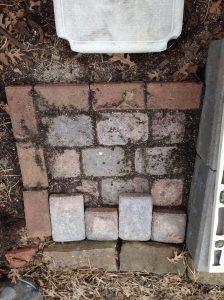It’s time to start clearing overgrowth, deadwood, weeds, etc. These photos were taken during the dead of winter.
 A major area that requires pruning is a climbing rose given to me as a cutting by my neighbor Marilene years ago. The small, pink climbing rose is pretty, but it quickly turned into thorny brambles that I wasn’t expecting. It grows like a weed and roots everywhere it touches soil. I need to cut it back and train it to grow where I want it.
A major area that requires pruning is a climbing rose given to me as a cutting by my neighbor Marilene years ago. The small, pink climbing rose is pretty, but it quickly turned into thorny brambles that I wasn’t expecting. It grows like a weed and roots everywhere it touches soil. I need to cut it back and train it to grow where I want it.
In addition, Passion Flower vines have traveled underground and sprouted up throughout the garden. I want to save some of these, but many have died in the last freeze and they must be removed. At any case, they need to be cut back.
 Update 1/24/2017
Update 1/24/2017
The photo to the left was taken from behind the chiminea. I usually let this corner of the garden grow a little wild. Garden lore says that if you let a small space in the garden grow wild, “the fairies” will live there and make your garden grow lavishly!
If that’s true, the fairies should be delighted. This area is so overgrown at this point that the lines of the labyrinth can’t be seen. There is much to clear.
However, there is some St. Augustine grass that has grown into the beds. I need to leave that so that I can move it in the spring. Also, leaves must be left in the beds to insulate the ground from the cold. There is also another major climbing rose planted in this area. Everything else can be removed.
Update 1/27/2017
I pulled down the deadwood from a multi-trunk ornamental tree in the corner. 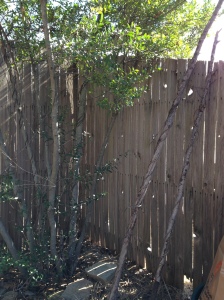
Update 2/12/2017
I removed much of the excess at the end of January. I took photos today. We’ve had a few warm days here, and the roses have begun to show leaves. I need to finish that project before the leaves become thick.
This is the same arbor as the first photo above. I basically cleared all the dead stems. Now I have to tame them.
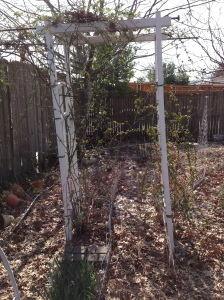
The next two photos are (1) taken from behind the chiminea, showing the same area as the second photo in this post, and (2) the area directly to the right of it, which has also been cleared. What remains are “volunteer” trees, which will have to be dug out by the roots.


Save
Save
Save
Save

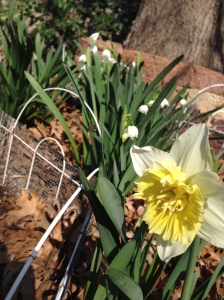 We’ve had a few warm days, although the cold weather won’t stay away for long. All of a sudden, I have daffodils and lily-of-the-valley blooming. I’ll get these marked on my new layout plan.
We’ve had a few warm days, although the cold weather won’t stay away for long. All of a sudden, I have daffodils and lily-of-the-valley blooming. I’ll get these marked on my new layout plan.
 A major area that requires pruning is a climbing rose given to me as a cutting by my neighbor Marilene years ago. The small, pink climbing rose is pretty, but it quickly turned into thorny brambles that I wasn’t expecting. It grows like a weed and roots everywhere it touches soil. I need to cut it back and train it to grow where I want it.
A major area that requires pruning is a climbing rose given to me as a cutting by my neighbor Marilene years ago. The small, pink climbing rose is pretty, but it quickly turned into thorny brambles that I wasn’t expecting. It grows like a weed and roots everywhere it touches soil. I need to cut it back and train it to grow where I want it. Update 1/24/2017
Update 1/24/2017



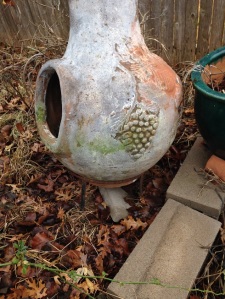

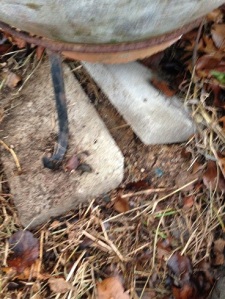
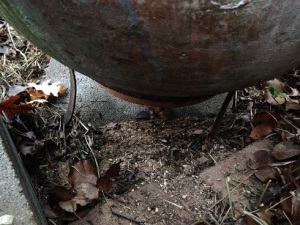

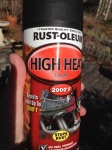 I found this product at Home Depot. It is Rust-o-leum High Heat spray paint that stops rust and will also withstand the high heat of the chiminea.
I found this product at Home Depot. It is Rust-o-leum High Heat spray paint that stops rust and will also withstand the high heat of the chiminea.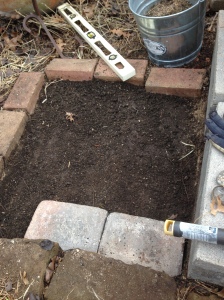 ______________
______________
